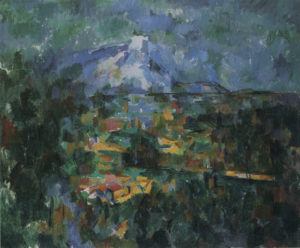R931 – La Montagne Sainte-Victoire vue des Lauves, 1904-1906 (FWN367)
Pavel Machotka
(Cliquer sur les images pour les agrandir)
In the last two paintings in the sequence of the Montagne sainte-victoire vue des Lauves, we see the surface almost as an end in itself. In one these, R931-FWN367, Cézanne has abandoned the shape of the mountain, painting it as a vague protrusion into the sky rather than the physical, continuous form that it is, and he has abandoned light; the meadows and the mountain, rather than reflecting the sun, are almost phosphorescent, and project an inner light onto the dark surroundings. All the elements we had seen in the previous landscape are there: the little houses still mirror the peak, and the path still balances the mountain’s back (although it is short here, because the mountain is short). But there is no illusion of space or volume; the painting exists on the canvas surface. If Cézanne has detached himself from vision here more than in any other landscape painted toward the end of his life, it is, I suspect, because of how much he has done with the motif already; he is free enough—or restless enough—to look for new ways of seeing it.
(voir la suite ici)
Source: Machotka, Cézanne: The Eye and the Mind


